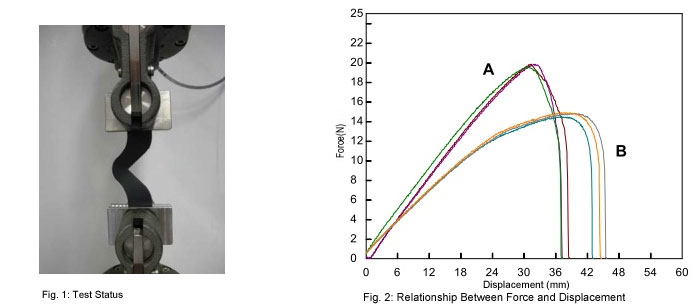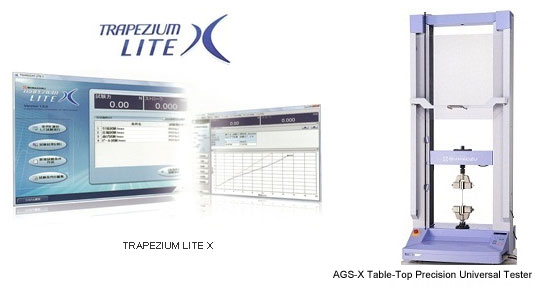Tear Tests of Angle-Shaped Rubber Specimens
Tear Tests of Angle-Shaped Rubber Specimens 【Standard No. ISO34-1: 2004 (JIS K6252: 2007)】
Introduction
Rubber materials have characteristic mechanical properties including elasticity and flexibility, and are widely used for industrial parts, construction materials, and housewares. In particular, a diverse range of synthetic rubber materials with differing properties suited to match their application have been developed. Measuring these mechanical properties is extremely important to ensure quality control and for new materials development. This Data Sheet introduces an example of the evaluation of two synthetic rubber specimens (angle-shaped specimens). Tear tests were performed, and the specimens were evaluated with respect to tear strength, one of their basic mechanical properties.
Measurements and Jigs
Tear tests of angle-shaped rubber specimens require grips that tighten automatically as the tear force increases. When tensile loads are applied to rubber materials, they elongate and their thickness decreases. For this reason, if there is no automatic tightening mechanism, the specimen will inadvertently break free of the grips before the maximum tear force is applied, making favorable measurements impossible. Accordingly, in rubber tear tests, it is necessary to use pneumatic parallel grippers, pantograph grips, eccentric roller type grips, Henry Scott type grips, or other grips equipped with this feature.
Measurement Results


The tear test results for the two samples are shown in Table 2. A graph showing the force-displacement relationship for each sample is shown in Fig. 2. Differences in tear strength between the samples are clearly apparent.
Rubber Tear Test System
| Tester: | AGS-X |
| Load Cell: | 1 kN |
| Test Jig: | 1 kN pneumatic flat grips (Single-side file teeth grip faces) |
| Software: | TRAPEZIUM LITE X |
- A high-precision load cell is adopted. (The high-precision type is class 0.5; the standard-precision type is class 1.)
Accuracy is guaranteed over a wide range, from 1/500 to 1/1 of the load cell capacity. This supports highly reliable test evaluations. - Crosshead speed range
Tests can be performed over a wide range from 0.001 mm/min to 1,000 mm/min. - High-speed sampling
High-speed sampling, as fast as 1 msec. - TRAPEZIUMX LITE X operational software
This is simple, highly effective software. - Jog controller (optional)
This allows hand-held control of the crosshead position. Fine position adjustment is possible using the jog dial. - Optional Test Devices
A variety of tests can be conducted by switching between an abundance of jigs in the lineup.



